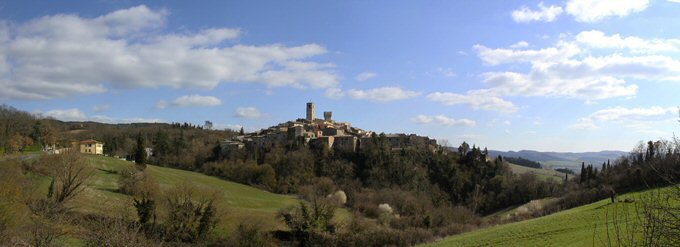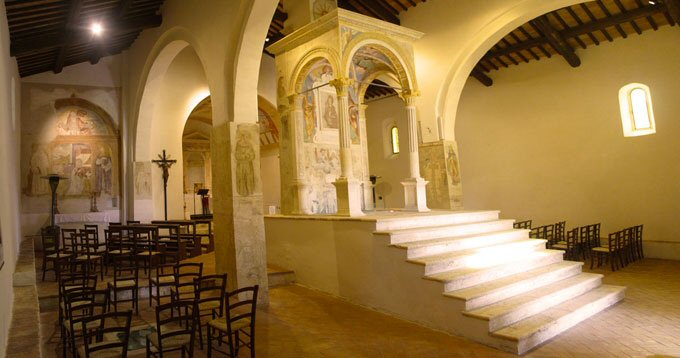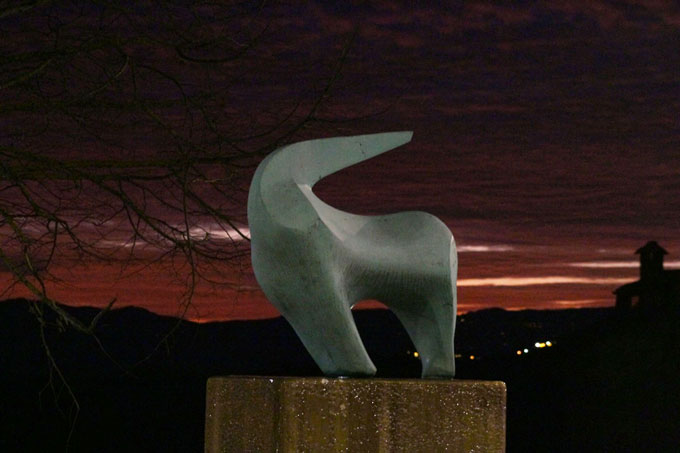San Casciano dei Bagni

Lat. 42.87156 Long. 11.87521 Alt. m. 582 ca.
On the southern slopes of Mount Cetona, perched on the top of a hill, stands the ancient village of San Casciano dei Bagni. Thermal water, clayey soil and uncontaminated vegetation has given fame to this territory since pre-history, favored by its central position and flanked by the road arteries of the Roman consular Via Cassia and the Via Francigena.
Historical outline
 The presence of Etruscans is proven by the discovery of the necropolis of Balena and by the evidence of Horace who dates the foundation of Fonti Clusinii (the ancient name of the place) to the time of Lucomo (Etruscan word for king) Porsenna of Chiusi. After the important Roman presence, which is witnessed by Santa Maria ad Balnea, one of the most ancient chapels of the diocese, there followed the transformation of the settlement from simple military encampment to fortified village, still visible today in the walls and gateways of San Casciano.
The presence of Etruscans is proven by the discovery of the necropolis of Balena and by the evidence of Horace who dates the foundation of Fonti Clusinii (the ancient name of the place) to the time of Lucomo (Etruscan word for king) Porsenna of Chiusi. After the important Roman presence, which is witnessed by Santa Maria ad Balnea, one of the most ancient chapels of the diocese, there followed the transformation of the settlement from simple military encampment to fortified village, still visible today in the walls and gateways of San Casciano.
The territory reached the peak of its prosperity in the XVII-XVIII centuries; today the village has rediscovered its ancient thermal vocation and can boast of one of the most prestigious spas in the world, all in a setting of uncontaminated territory and an untouched landscape.
Visit the village

Arriving in the main square, Piazza Mateotti, you will enjoy the breath-taking view over the valley where numerous thermal springs rise, gentle hills and, in the distance, the Val di Paglia. Sitting on a bench, taking a stroll or sampling local products are pleasures you cannot renounce.
 After passing by La Bestia, a modern sculpture by Bizhan Bassiri, enter the village walls through the main gate. The village reveals itself in its extraordinary beauty; go up St. Cassian Street to the Collegiata of St. Leonard which catches your eye with its medieval Cistercian portal, rediscovered in 1948 in the wall of the adjacent Oratory and then placed in its present position, and also the bell tower (1606) which tirelessly marks the passage of time. The interior houses over the altar the Coronation of the Madonna (second half of the 15th century) and other fine works (13th -16th century).
After passing by La Bestia, a modern sculpture by Bizhan Bassiri, enter the village walls through the main gate. The village reveals itself in its extraordinary beauty; go up St. Cassian Street to the Collegiata of St. Leonard which catches your eye with its medieval Cistercian portal, rediscovered in 1948 in the wall of the adjacent Oratory and then placed in its present position, and also the bell tower (1606) which tirelessly marks the passage of time. The interior houses over the altar the Coronation of the Madonna (second half of the 15th century) and other fine works (13th -16th century).
Adjacent to the Collegiata is the Church of St. Anthony. The 14th century wooden statue of the Madonna and contemporary works by Bassiri are noteworthy.
When you arrive at the square in front of the Town Hall, decorated with coats of arms of the Podestà (the officials of government), you find a well made of local stone. Continuing along the narrow streets you can go down towards the Porticciola or, going in circular fashion towards the Piazzetta del Pozzo (the square with the well) you will see the Church of the Holy Conception, an oratory of the 16th century which contains the original structure and frescoes of Pomarancio. On your way back up to the main square you pass by Teatro Comunale with its graceful, welcoming interior. The ex Academy of the Georgofili Accalorati was built in the 1700's and later substantially transformed.
Environs
At Fonteverde Thermal Centre you can admire the Portico della Ficoncella (1607) and nearby the ancient church, Santa Maria della Colonna, the former Santa Maria ad Balnea, dating back to the IV-V century A. D., which contains amazing works of Renaissance age.
Walk around San Casciano dei Bagni
Visualizza Percorso 1 - Il borgo di San Casciano dei Bagni in una mappa di dimensioni maggiori